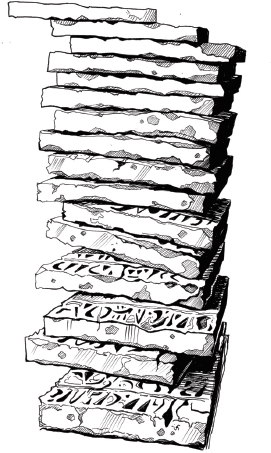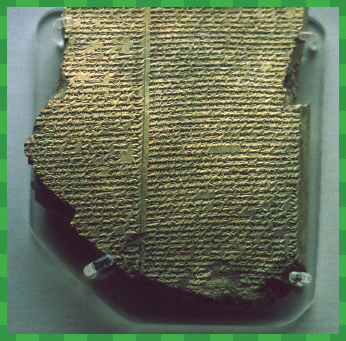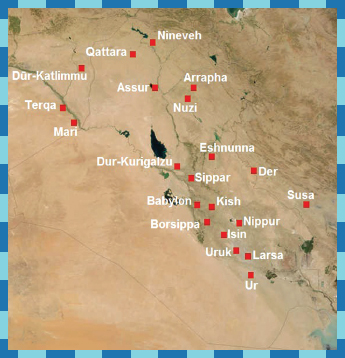
Chapter
5
Gilgamesh
Two-Thirds Divine
Lived: Twenty-seventh century BCE, Mesopotamia
Occupation: King of Uruk, Demigod, Political Pawn
If It Looks Like a Legend, Smells Like a Legend, and Walks Like a Legend . . .
Gilgamesh the king is remembered best for slaying monsters and being a royal pain in the butt. He annoyed everyone from his subjects to the Mesopotamian gods before they decided to put his hero capacity to the test. When he passed with flying colors, he conveniently became every wannabe-king’s long-lost ancestor.
Yes, in his day, Gilgamesh was a megastar. But that day was a long time ago and humans sort of forgot about him—until 1872.
The setting was Victorian London. The dark, musty-smelling archives of the British Museum housed thousands of baked clay tablets with weird lines that looked a lot like chicken scratches. But they weren’t. They were cuneiform, a type of ancient writing that people had stopped using 1,700 years ago. These tablets had sat untranslated for years at the museum, and it wasn’t until one persistent research assistant, George Smith, got down to the eye-ruining work of deciphering those chicken scratches that the ancient king re-awoke.
One day, George was reading at a table stacked high with tablets when one fragment of baked clay sang to him.
Words like “flood” and “boat” and “animals” jolted him up like a bucket of ice water down the neck. Thinking he had found confirmation of the Biblical story of Noah’s ark, George forgot all about his stuffy Victorian ways. He started jumping up and down and undressing himself as if ice cubes really had gone down his neck.

A loud-mouthed soprano is in there somewhere, just waiting to be discovered.
Queen Victoria would not have approved.
The tablet George had found was a fragment from the Epic of Gilgamesh and the finding would eventually shake Victorian society’s beliefs in their precious Greek poet Homer—the original king of epic stories.

This is the Flood tablet, but you already knew that if you’re fluent in chicken scratches.
So who was this Gilgamesh, hero of Sumer? How did the real man ever get mixed up with the demons and monsters of the epic? And was this really a reference to the same flood of the Bible?
A reconstructed Ziggurat of Ur. Demigods not included.
Spielberg Worthy
Gilgamesh was the son of a king and a goddess, which certainly helped his hero status. According to the legend, Gilgamesh had more of his mom than his dad in him, and we’re not talking about eye shape. He was two-thirds divine and only one-third human. Gilgamesh couldn’t get over how cool he was, and he didn’t let anyone else get over it either.
He went around town—the ancient city of Uruk to be precise—doing whatever he wanted. That included stealing other men’s girlfriends and making his people participate all day in meaningless competitions. It would be fair to say that he was history’s first badly behaved royal.
Eventually, his subjects couldn’t take it anymore. They started grumbling—loudly. Gilgamesh wasn’t so cool or funny to them anymore, and they wanted their girlfriends back. They prayed to their gods at the city’s ziggurat, and for once, their prayers were answered. The gods agreed: Gilgamesh was too big for his britches (or in the case of ancient Uruk, his sheepskin loincloth).
The gods put their heads together and came up with a plan to teach Gilgamesh some humility. They created a wild man, more beast than human, who was equal to Gilgamesh in strength. They named the man Enkidu and turned him loose on the countryside.
Mayhem broke out in the forests around Uruk, and hunters began to complain to Gilgamesh, begging him to do something about Enkidu. The gods rubbed their hands in anticipation. Finally, the king would get just what he deserved—someone else equal to him in the annoying department. But Gilgamesh didn’t have to think long. He knew that only one thing could stop this hairy beast-man—a woman. He chose Shamhat. She only needed a week before she had Enkidu wearing clothes, walking on two legs (instead of four), and even singing.
After he had been tamed, Enkidu walked right into Uruk, sought out Gilgamesh, and professed his undying loyalty. Some versions say the two wrestled first, but either way, they soon became fast friends. Together, they did all sorts of things best friends in Mesopotamia did, like slaying forest monsters, irritating a goddess, and fending off more beasts sent by the irritated goddess.
The gods decided that Gilgamesh must pay for his flippant attitude, and the only way to get even with him was to kill his best friend. When Enkidu died, Gilgamesh decided to undertake a quest for immortality. That dying business just wasn’t his thing.
His quest took him all over the known world and even into the Underworld. According to rumor, the man who had survived the Flood, Utnapishtim, was granted immortality, and Gilgamesh was determined to find him and make him spill his secrets.
After a long search, Gilgamesh found Utnapishtim and his wife and, in his usual brash manner, demanded the secrets of the gods. So Utnapishtim played along. He told Gilgamesh that if he could stay awake for six days and seven nights, then he might be able to overcome death. Gilgamesh agreed, then promptly fell asleep for a full week. Of course he tried to deny it, but the writing was on the wall. Or rather, on the moldy bread left out each day by Utnapishtim’s wife to mark the time.
By the end of the epic, Gilgamesh finally realized he could never outwit death and accepted life as it came.
Historicity: Just a Fancy Word for What Really Happened
What would ever make people think that a story like this could be true? As it turns out, it was more chicken scratches. In 1922, a real outdoorsy guy named Herbert Weld-Blundell dug up a four-sided tablet called a prism in the sands of an ancient city-state. It made everybody’s eyes pop out of their head when it went on display.
Maggots tell no lies.
The Weld-Blundell Prism (catchy name, huh?) listed the names of every king in Sumer from the shadowy beginnings of life to 1800 BCE, which was when the tablet was written. Guess who made the list? That’s right, Gilgamesh the King of Uruk. But if you think this settled the matter of his existence, you’re wrong.
The lengths of the kings’ reigns were longer than the most boring class you’ve ever had to sit through. According to the list, kings ruled for as long as 43,000 years and although some classes may feel that long, it’s an impossible amount of time for humans to imagine living. Compared to these early kings, Gilgamesh’s reign was pretty reasonable, clocking in at a measly 126 years.
Maybe imagining Gilgamesh as a real king wasn’t so crazy. Later excavations turned up pottery shards with his name as well as other names from the king list. Archaeologists even found walls around Uruk dating to the time when Gilgamesh supposedly had them built.
At the very least, these findings suggest that a king named Gilgamesh may have existed, become extremely famous, built walls to defend his town, and as these things tend to happen, accumulated legends and admirers like barnacles on a ship. He was deified by 2500 BCE, and since then, the world has never known what’s fake, and what isn’t.
The truth is, there are no contemporary sources from Gilgamesh’s time to prove his existence. Unless more evidence turns up, the reality of Gilgamesh could go either way. But scholars will probably argue about it for years to come, if you’re interested in that sort of thing.
All those tablets do confirm something: Mesopotamia had a lot of kings.
It’s Not Done Yet!
Remember all those stacks of tablets in the British Museum that were found in the 1870s? Well, they’re still there, and many are waiting patiently to be deciphered. In early 2014, the assistant keeper of cuneiform tablets at the British Museum, Irving Finkel, announced he found the blueprint to the Babylonian ark. Turns out, Utnapishtim’s ark would have been round and a bit smaller than a soccer field. The “blueprint” is really just another clay tablet describing the dimensions of the boat that Gilgamesh’s poets decided to leave out, probably so they didn’t bog down the excitement of Gilgamesh’s week of sleep. Some think this is where the writers of Noah’s ark got their idea—from Utanpishtim’s ark.
Who knows, you could be the next person to discover a huge breakthrough in the legend of Gilgamesh. It could be you who jumps up and down and takes your shirt off in celebration—just like George Smith.
Getting into the Legend Business Isn’t Easy, but Someone’s Got to Do It
So if Gilgamesh was a real king, and not some legendary phony, how did he turn into a superhuman character in an epic story?
Enter a king with a head for business.
Shulgi was the second king in the third dynasty of Ur, which means he ruled the city from 2094–2047 BCE.
third dynasty of Ur:
Lots of big stuff happened in the third dynasty of Ur (monsters and demi-gods not included). Most of it happened thanks to Shulgi, who created a standing army, a calendar, and standardized boring administrative records—dull, but necessary, if you’re going to be a successful ruler.
He had a big man crush on Gilgamesh, whose name was still floating around six hundred years after his supposed reign. Since we have no existing fragments from this period, we don’t know exactly what people were saying about Gilgamesh, but clearly they were talking. All Shulgi wanted was for people to think about Shulgi when they told Gilgamesh stories.

Ancient Mesopotamia circa Shulgi the Avenger’s reign.
What better way to have his lowly subjects make the connection between Gilgamesh and himself than more stories? Shulgi decided to write Gilgamesh’s stories down, but he wanted to be in them too; otherwise writing them down would be useless. The whole point of the stories was to give two thumbs way up to Shulgi’s kingliness.
So Shulgi squeezed himself into an epic as Gilgamesh’s brother, and he changed the curriculum of scribal schools to include poems and hymns praising his own awesomeness. The image wouldn’t be complete without an appropriate nickname, and thus Shulgi the Avenger was born, minus any superhero’s cape. He didn’t wait till he was dead to have people sing his praises; he commanded it while he was alive, proving just how fuzzy the lines between history and legend can get in the greedy hands of a dictator.
Gilgamesh got the last laugh, though. Shulgi might have used his name and abused his memory for his own purposes, but it’s Gilgamesh that people still remember. (Which is a shame, really, since Shulgi was the first to use writing for things other than keeping track of goats and grain—those boring administrative records at work!)
After that, Gilgamesh had a new history—his legend. It was tweaked orally and re-tweaked in writing over and over and over again until we had a bunch of different versions of the story. And like any bestselling novel, The Epic of Gilgamesh has been translated into different languages throughout its long history, changing to fit new audiences whom embellished and expanded the old stories. The Babylonians went further; they strung the Sumerian tales together into a cohesive story, added in new story bits (Utnapishtim and the Flood), and upgraded Enkindu’s servant status to best friend status.
Before there ever was a New York Times bestseller list, there was the original: Gilgamesh.
The First at Everything
When you’re the world’s oldest civilization, it’s easy to be the first at everything. The first to read, the first to write, the first to build cities and canals, the first to use a plow, and so on. It comes as no surprise, then, that this ancient Sumerian culture gave us the first epic poetry and the first superhuman character.
Of all the epics to come out of Mesopotamia—and there are quite a few—Gilgamesh’s are the most widespread and the most copied. They were found all over the present-day Middle East, ranging in date from Shulgi’s literary reforms until the second century BCE. That’s 1,900 years! It’s possible that archaeologists might find even older copies someday.
epics:
Including epics about characters with equally awesome names like Sargon, Lugalbanda, and Etana.
Since the world wasn’t isolated in the Bronze Age, even faraway places like Greece and Rome knew about the badly behaving Gilgamesh. Wars, trade routes, migrant workers, travelers, and mercenary jobs all brought these cultures into contact with each other. People did all the sorts of things people do when they get together: shared stories, married, and killed one another. (Isn’t that your typical picnic gathering?) As a result, Gilgamesh and his tales spread far beyond Mesopotamia, influencing cultures throughout the known world.
cultures:
Even the monsters in the epic found themselves in the limelight. The epic’s forest monster, Huwawa, is also mentioned in the Dead Sea Scrolls and in the medieval work by the Manicheans known as Book of the Giants.
The biggest debate between scholars is how much Gilgamesh influenced One Thousand and One Nights (a.k.a. Arabian Nights) and also Homer (The Iliad and The Odyssey—see chapter 9).
Achilles, the Greek hero of the Trojan War, and Gilgamesh could be twins, they’re so alike. Both are sons of a goddess and king; both are so close to immortality that they could practically taste it; and both are so messed up emotionally that they’re the world’s first manic-depressives.
One minute they were weeping bitterly, and the next they were ready to cut off heads and party like it’s the end of the world. Both had close buddies who died, forcing them to talk about their feelings, and eventually they both realized that no matter what, death would come for them. Oh well—carpe diem! (Which has nothing to do with fish, but with seizing the day.)
It’s possible that the Greek bards who traveled around various Greek cities singing and performing Greek stories heard Gilgamesh’s stories themselves from narus.
narus:
The Near Eastern version of bards—storytelling singers—but can also refer to the type of boast-filled stories about kings that filled tablets.
They may have even heard the stories from captured soldiers, who were turned into slaves after wars. Maybe they remembered bits of stories and thought, “Perhaps I’ll just adjust it a bit for my audience.”
There’s no reason to assume that the Greek bards straight plagiarized from Eastern traditions, but there’s no reason to think they didn’t get a bit of inspiration, either. Too many of the same themes, motifs, and characters are present in both traditions. The same thing happens today for writers everywhere. As it’s been said: there’s nothing new under the sun.
A Merry-Go-Round of Opportunity
Mortality, friendship, and the acceptance of death—these themes can be found in modern books today, but they all began with Gilgamesh.
When Gilgamesh was uncovered in Victorian times, it didn’t immediately take the world by storm. At first, only angsty poets, artists, and psychoanalysts—like Sigmund Freud and Carl Jung—salivated while reading about Gilgamesh. Upon reading the epic, the famous Austrian poet Rainer Maria Rilke exclaimed, “Gilgamesch ist ungeheuer!” which means something like, “Gilgamesh is the man!”
Gilgamesh for the People
The Mesopotamian idea of the afterlife was scarier and crueler than a surprise pop quiz on a Friday afternoon. Nothing grew in the Netherworld, and the dead only drank brackish water and ate stale bread. The dead spent their days hoping the Queen of the Dead, Ereshkigal, didn’t notice them moping about and send her demons to punish them. And that was the afterlife for people who had been good and obeyed the gods’ whims their whole life. It’s no wonder Gilgamesh thought dying was a raw deal. His quest for immortality ultimately gave the Mesopotamian people hope. At the end of Gilgamesh’s story, the gods grant him a form of immortality—he becomes the greeter of the dead (like Saint Peter in Christian culture) and the judge of the dead (like King Minos in Ancient Greek culture). Gilgamesh’s story finally gave Mesopotamians something to look forward to after death—they would be able to meet their hero, the great king!
It wasn’t until after WWII that Gilgamesh managed to infiltrate the rest of the world and capture its attention. Today, Gilgamesh is the star in many media forms, including textbooks, theater, ballet, videogames, novels, comic books, anime, and radio broadcasts. There’s even a Gilgamesh-themed restaurant located in London.
All in all, Gilgamesh of the epic tale is fake. It’s even possible that Gilgamesh of Uruk is a fraud, too. Scholars just don’t know. If he did exist, he wasn’t running around for 126 years like the Sumerian King List says he did. But his legacy does exist, and it helped shape Western and Eastern literature for centuries. That’s some pretty legendary stuff.